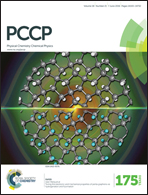Low-energy excited states of divanadium: a matrix isolation and MRCI study†
Abstract
The ground and excited electronic states of the vanadium dimer (V2) have been studied using Ne matrix isolation experiments and quantum chemical calculations (multireference configuration interaction based on complete active space self-consistent orbitals). In the near infrared absorption spectrum, two vibrational progressions of a new electronic term with a large number of members have been observed with the origin at 1.08 eV and a fundamental vibrational quantum of 475 cm−1. With the aid of calculations, it has been assigned to a 3Πu electronic term. The calculations yield potential energy curves for a large number of singlet, triplet, and quintet electronic terms.


 Please wait while we load your content...
Please wait while we load your content...